 |
||
|
||
| ||
Processors from VIA appeared on the market a long time ago, but during such a long period they failed to gain popularity. As the experience shows, even on the low-end processor market the price is not a determining factor. And the problem is not connected with superiority of some processors. The processors from VIA Technologies are still based on the old core developed by Centaur, where a computing unit with a floating point is a weak point. As a result, it doesn't suit home computers with their games greedy for a coprocessor. But on the corporate market where integer-valued instructions dominate the VIA processors do not have such problems. However, there is another obstacle. The problem consists in quite short time of existence, as compared with the computer giants, and insignificant means invested in the marketing and the trademark of C3 processors. People who are in charge of purchasing of computer equipment on the corporate market are often far from what is happening on the IT market. Nevertheless, everyone knows Intel and many heard about AMD, while the name "VIA C3" is not well known. They need reliable brand-name equipment. That is why even the performance equal to the one from competitors in business applications together with an attractive price is a factor of minor importance. And now, while marketers are fighting against the stereotypes all around the world, the engineers of the company are improving the processors, and some day the priorities will probably change. Today, for example in the Eastern Europe, we have VIA C3 733/133 MHz and VIA C3 Ezra 800/133 MHz processors. The C3 processor is just a renamed Cyrix3 with Samuel2 core, which we have already examined. It works, though, not at 667 MHz but at 700 and higher. The most productive at that is a processor working at 733 MHz since it is designed for a 133 MHz bus while 700 and 750 processors operate with a 100MHz bus. The second processor is, however, more interesting - VIA Technologies promised to use a new core C5X in the Ezra processor, which meant higher performance especially as far as calculations with a floating point are concerned. But the sensation didn't take place: the core was the same as in the C3, and only TSMC (Taiwan Semiconductor Manufacturing Company) transferred it to the new fab process - 0.13 micron. Well, it is obvious that the new performance boost should be expected only from the Nehemiah. But even lifting of clock speeds of the current core with the finer technological process is difficult. The processors are almost impossible to overclock, what means a low frequency potential of the C3 core. It seems to be even lower than that of the similar architectures of the competing processors - P6 and K7. Well, the way-out is only one: it is necessary to change the core. Nevertheless, such a fine fab process provides a low prime cost. As a result, the processor business in the low-end sector is more profitable for VIA than, for example, for AMD which has to sell its budget processors at the prime cost or even lower in order to maintain its niche. Besides, lower power consumption allows making noiseless and ungreedy for power systems (a low-power supply unit, as well as the processor, doesn't require cooling with a fan), and makes possible to save on a heatsink and a case. Taking into consideration this conception it is a good idea to join an almost cold processor with the Terminator from ASUS described a couple of months ago. By the way, it has already appeared on the market. But there is a more suitable company - the cheapest mainboards based on the cheapest VIA's chipset - PLE133. It is interesting that the PLE133 based boards cost almost equally - the fight on the budget market is so severe that the most expensive manufacturer ASUS offers products at liberal prices. So, here are 4 PLE133 based boards and only one processor - VIA C3 733 MHz.
EPoX 3VWM2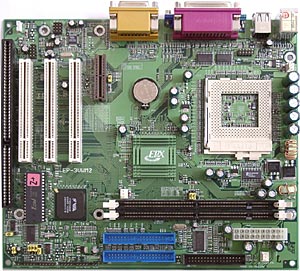 The boards from this company have wide possibilities of adjusting settings together with a high speed and stability. The 3VWM2 is the largest board in our review. The board we received was packed in a box of an old design. Apart from the board it includes a user's manual, a bracket with an additional serial port for the rear computer panel, ATA66/100 and FDD cable. There is also a CD with a driver, utilities and a user's guide. Among the programs there are such as Adobe Acrobat Reader 4.05, Norton Antivirus 2000, Norton Ghost 5.1, DirectX 7a and a utility for program processor overclocking from Windows - Boostek. Besides, you can find utilities for system monitoring - from EPoX, from VIA and Winbond. The board is based on the v1.1, but it has an unsoldered audio-out connector for the front computer panel. All functional elements and connectors are placed conveniently. The only drawback is a position of audio-ins and a connector for additional USB ports located in front of PCI slots. There are 15 Low ESR (marked as L.E.S.R.) capacitors: 5 of 2200uF and 10 of 1000uF. There are also jumpers for setting the base processor frequency - 66,100,133MHz and for adjusting a multiplier - from 1.5X to 8X. But the latter function is unfortunately locked in the processor. It can be enabled only in some pre-production samples. The BIOS is based on v6.00PG from Award. You can adjust memory timings, a correlation of FSB and memory frequencies, modes of an integrated video adapter, as well as to overclock the processor. With the 66 MHz of the base frequency we may set the following frequencies: 66, 75 and 83 MHz, at 100 MHz - 100, 103, 112 and 124 MHz, at 133 - 133,140 and 150 MHz. But you mustn't forget about the stability of operation which is appreciated much more in this sector than speed. Well, this board is a good solid product which excellently suits any office computer. And if you equip it with a powerful video solution (e.g., GeForce 2MX PCI from NVIDIA) such computer will be a good choice for an undemanding gamer. Asus CUPLE-VM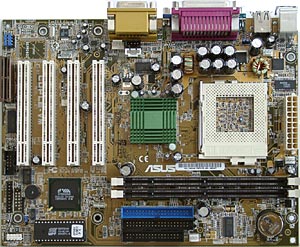 This board is the smallest model in our review. But it has the largest number of PCI slots and lacks for an ISA one. Such solution corresponds the latest specifications of the industry but is not compatible with old expansion cards. The board we received is a pre-production sample. However, the package contains ATA66/100 and ATA33 cables, an FDD one, brackets for the rear panel with 2 USB ports and with a serial port, a user's guide and a CD. The CD offers a standard software set from Asustek - drivers for the board, Adobe Acrobat Reader 4.05, PC-Cillin 2000 v. 7.0 from Trend Micro, Power Player SE 5.0, PowerDVD Trial 3.0, VideoLive Mail 4.0 from CyberLink, 3Deep for adjusting color balance, and ASUS programs - screensaver, ASUS Update and ASUS PCProbe (system monitoring utility). The board has only two switches, and both are meant for switching on a computer from mice and keyboards with a USB connector. The model is very convenient: all components take the best for them places. The feed circuits have 12 1500uF capacitors. The board of the v1.03 has several unsoldered chips and connectors - it can optionally be equipped with an audio solution from Creative based on the CT5880 chip. The BIOS is based on the Award Medallion BIOS. It lacks for a possibility
to overclock the CPU, except the function of FSB Acceleration. You may,
for example, enable this function at 133 MHz FSB and get 140 MHz on the system
bus. But there are a lot of settings for memory, AGP bus on which an integrated
video adapter works. Besides, you can change the correlation of memory
and FSB frequencies.
Biostar M6VLB In the box you can find the board, ATA66 and FDD cables, a 2-page installation manual and a CD which contains drivers, utilities for system monitoring, a user's manual in .pdf format and Adobe Acrobat Reader. Well, a rather scarce set. The layout is not perfect - audio-in connectors are located in front of PCI slots, and an inconvenient position of an ATX power supply connector between the socket and AMR slot brings to nought all efforts of cooling of the system block since a thick bundle of cables impedes air circulation. The feed circuits have 7 1500uF capacitors. The only jumper on the board serves for cleaning CMOS content. The BIOS is based on v6.00PG from Award and offers not a wide range of settings. Although you can choose a memory frequency, its timings can't be adjusted. Furthermore, you can't change anything in operation of the CPU. The processor's and board's temperatures are not displayed either. Well, this board will suit only for the most unpretentious user, who is short of cash at the same time. FIC FR33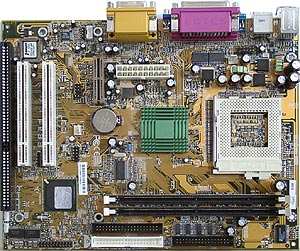 Apart from the board, a stylish yellow box contains ATA66/100, FDD and usual 40-conductor cables, user's guide, a blank for registration in the fan club of this company and 2 CDs. Here you can discover the widest software set among all others of this review. The first CD (CD Pro) has FIC utilities - Audio Alert II, Clockometer (for system monitoring), LogoGenie 2.1 (for changing pictures in BIOS). Besides, there are Media Ring Talk 99 and some other utilities. The second CD (CD Plus) contains Norton Antivirus 2000, Norton Ghost, Norton Virtual Drive, Appio (a helper in making purchases on the Net), AutoSave (auto backup of data), X-Stop (for restriction of an access to definite sites), Cute Dialer (dialup manager), ImageMore (graphics file viewer with a collection of pictures) and Adobe Acrobat Reader. The board doesn't differ much from others in this review. But it is the only which has just 2 PCI slots and is equipped with an old south bridge. There are only 7 capacitors, each of 1500uF. Unlike other contestants, the board has a connector for external audio-outs located on the front computer panel. The jumper is only one; it cleans the CMOS contents. Other settings are hidden in the BIOS Setup. The BIOS is based on v6.00PG from Award and offers a great deal of settings. You can set the most favorable modes for each memory module, adjust the AGP bus, and set FSB frequencies - 66, 75, 83, 100, 103, 112, 124, 133, 140 and 150 MHz. It is a very pleasant solution, and it is very good that FIC has done its best in developing this budget solution. PerformanceTest equipment:
Software:
It is interesting that all the boards show almost identical results of the performance. That is why we have decided to display the results of only one board. Today we will just look at the performance of the VIA C3 processor in comparison with its closest competitor - Intel Celeron 733/66MHz on the same platform - VIA PLE133. The platform allows conducting only office tests. 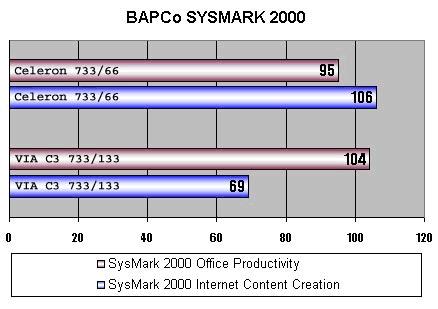 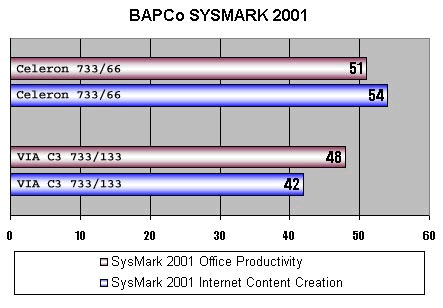 On the modern tests which start all applications simultaneously and use them in turn, the VIA processor performs worse than on the aging SYSMARK 2000 which implements scripts on a single application. This is the second weak point of the VIA CPU: it is either an organization of the cache memory to be blamed which makes much more mistakes than in case of Intel, or its latency. As a result, even the fast 133 MHz bus can't improve the situation. ConclusionThe link VIA PLE133 + VIA C3 will make a computer work at
the decent speed. Looking at the diagrams you should take into account
that if you are buying a computer for an office the higher scores
will mean for you that a file in the Word 2000 will open faster
by 0.5 sec... On the whole, the processors are rather good: they
heat faintly, consumes not much, are inexpensive and rather swift
for their tasks.
Write a comment below. No registration needed!
|
Platform · Video · Multimedia · Mobile · Other || About us & Privacy policy · Twitter · Facebook Copyright © Byrds Research & Publishing, Ltd., 1997–2011. All rights reserved. | |||||||||||||||||||||||||||||||||||||||||||||||||||||||||||||||||||||||||||||||||||||||||||||||